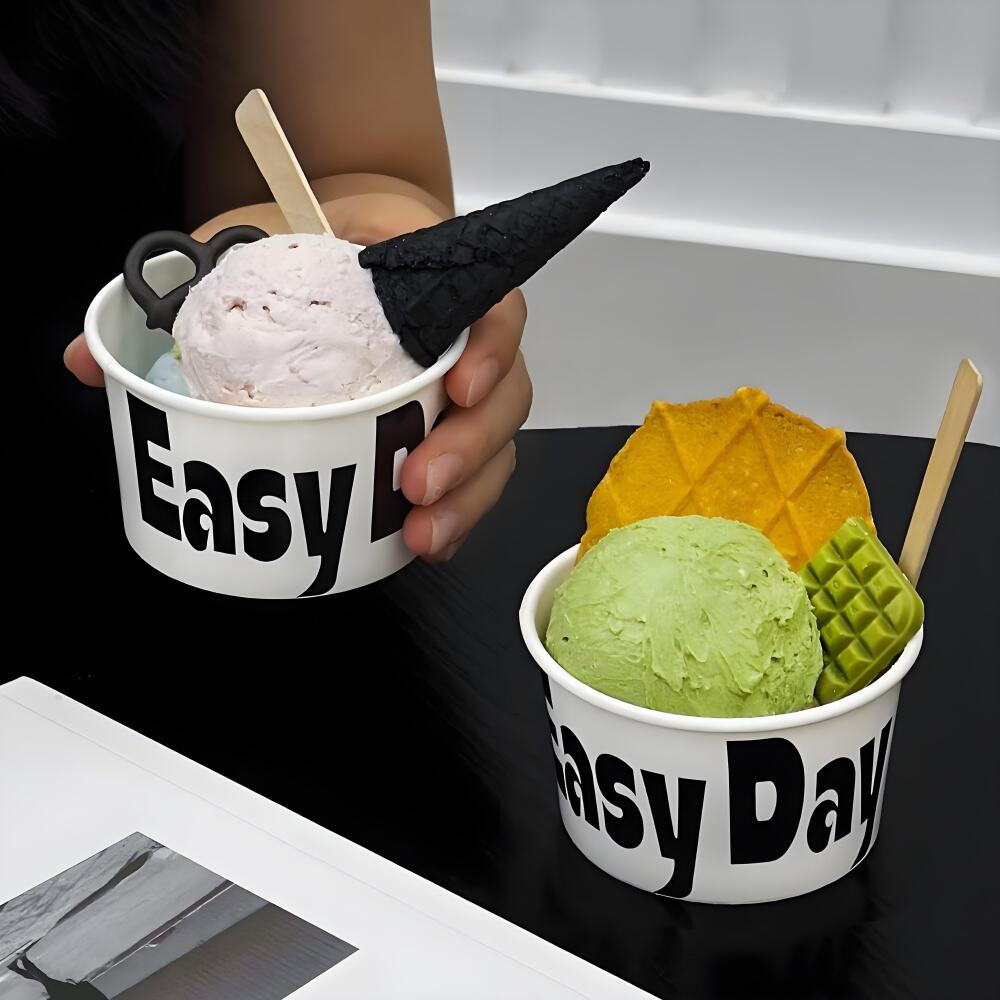Key Insulation Features in Ice Cream Cups
The Science Behind Insulated Cups for Temperature Retention
Insulated cups minimize heat transfer through conduction, convection, and radiation. Double-wall designs create air gaps that reduce thermal exchange by up to 70% compared to single-layer cups, effectively isolating ice cream from ambient warmth and slowing melt onset. This principle is supported by research into thermal insulation dynamics.
How Cup Performance in Maintaining Cold Temperature Varies by Design
Cups with foamed-plastic walls containing microscopic air pockets keep contents 50% colder than standard designs, according to a 2025 Plastics Engineering study. Double-wall construction extends cold retention from 45 minutes in single-wall paper cups to over 90 minutes by trapping insulating air layers, significantly improving user experience during outdoor consumption.
Comparative Analysis: Foam, Plastic, and Paper Based Insulation Effectiveness
Foam cups maintain sub-freezing temperatures for 65 minutes—40% longer than PLA-lined paper alternatives. However, expanded polystyrene (EPS) foam requires three times more energy to produce than biodegradable materials, posing sustainability challenges despite its superior insulation.
Role of Air Pockets and Double Wall Construction in Thermal Resistance
Air’s low thermal conductivity (0.024 W/m·K) makes it an effective insulator. In double-wall cups, each millimeter of air gap improves thermal resistance by 12%, helping prevent condensation while maintaining structural integrity through repeated freeze-thaw cycles.
Material Selection: Balancing Performance and Sustainability
Material suitability: Evaluating durability and cold resistance
PLA and PE stand out among materials because they can handle pretty cold temperatures ranging from around minus 20 degrees Celsius up to 40 degrees without breaking down much. According to recent testing done last year, PLA stays firm for well over half an hour when kept at room temperature conditions, which is actually three times better than regular old paper without any lining. EPS does great with keeping things warm inside though, it just starts getting squishy if exposed to anything colder than ten below zero Celsius. That makes EPS not so good for places where really harsh winter weather is common, like those remote Arctic research stations everyone reads about sometimes.
Moisture resistance and lining (PE/PLA): Why it’s critical for structural integrity
PE coatings reduce moisture penetration by 87% compared to uncoated paperboard. Dual-layer PLA liners extend resistance to condensation-induced sogginess beyond 60 minutes essential for maintaining cup shape during extended service. High-performance cups achieve % leakage using liners of at least 18µm thickness with heat-sealed seams.
Sustainability vs. functionality: The trade offs between biodegradable and synthetic materials
While 72% of consumers prefer biodegradable packaging, the Institution of Structural Engineers notes PLA-based cups have a 23% higher incidence of melting in humid climates compared to PE-lined versions. Petroleum-based materials offer 40% better thermal stability at sub-zero temperatures, creating a functional-environmental dilemma for brands aiming for eco-friendly solutions.
Industry Paradox: Consumer demand for eco-friendly cups vs. melting risks
A 2024 survey showed 52% of buyers prioritize sustainability, yet 38% reject biodegradable options after experiencing melt-related messes. This gap has driven R&D into hybrid materials like algae-enhanced PLA composites, which demonstrate a 15°C improvement in heat resistance over conventional bioplastics.
Lid Design and Sealing Technology for Temperature Control
Types of Ice Cream Cups with Lids and Their Sealing Efficiency
The different types of container lids offer varying levels of thermal protection depending on their design. Snap on lids will stop spills pretty well, though they let heat in about 30 percent faster compared to those twist on screw tops. Then there are heat sealed lids which create really tight barriers thanks to special food safe glues. These can keep things at stable temperatures for around 40 to maybe even 60 extra minutes. When quality matters most, containers with double gasket silicone seals and threaded closures work best. They block out air with about 92 percent efficiency, which makes all the difference when storing foods that have delicate textures or need to stay fresh longer.
Functional Features: Practicality Meets Design in Modern Cup Lids
Modern lid engineering integrates four key innovations:
- Silicone valve vents that equalize pressure without compromising insulation
- Tamper-evident locking tabs ensuring seal integrity during transport
- Curved drip edges redirecting condensation away from cup walls
- Ultra-thin PP/PE hybrids (0.8–1.2mm) balancing rigidity and freeze resistance
These features help lids withstand the 67°F to 0°F thermal shock outlined in FDA frozen food handling guidelines, surviving 12+ freeze-thaw cycles without warping.
How Accessories Like Spoons and Drip Guards Impact User Experience and Melt Rate
Spoon clips that are built right in cut down on surface contact melting by about 18%. They work by stopping metal utensils from becoming thermal bridges. A lot of craft brands (around 43%) actually use these clear PET drip guards to stop condensation from collecting and speeding up the melting process. The Clemson University research team found something interesting too. Their 2025 findings showed that anti static coatings on various accessories can slash ice crystal formation by nearly 30%. This makes all the difference when it comes to keeping textures intact for snacks eaten over time rather than in one sitting.
Structural Integrity and Cold Resistance in Real-World Use
Performance Under Temperature Fluctuations: Preventing Cracking and Leakage
Ice cream cups endure multiple freeze-thaw cycles during retail handling. A 2023 analysis of 4,200 containers found reinforced rim designs reduced leakage by 63%. Critical factors include:
- Material Memory: Polypropylene retains shape through 40+ cycles; unlined paperboard degrades after 15
- Seam Engineering: Double-wall construction prevents condensation buildup at stress points
- Cold Flexibility: Thermoplastic elastomers remain flexible down to -30°F
These properties ensure reliable performance across diverse distribution environments.
Durability vs. Sustainability: Material Considerations for Commercial Use
Compostable materials introduce durability tradeoffs—plant-based PLA liners show 38% lower crack resistance than synthetic PE coatings in sub-zero conditions (BioPackaging Institute 2024). Operators must align material choice with usage patterns:
- Heavy-duty polypropylene survives 200+ dishwasher cycles
- Molded fiber alternatives last 6–8 uses before warping
- Hybrid PET-coated paperboard offers mid-range durability (45–60 uses) with 80% recycled content
High-turnover urban vendors often choose durable synthetics, while seasonal stands favor compostable options suited to shorter lifespans.
Innovations and Best Practices for Choosing the Right Ice Cream Cup
Materials and Designs Available for Next Gen Temperature-Stable Cups
Next-generation cups leverage biodegradable PLA liners, vacuum-insulated stainless steel hybrids, and aerogel-enhanced layers to achieve 30–50% longer cold retention. Phase-change liners that absorb heat during transit reduce melting risks by up to 40%, making them ideal for delivery-focused brands.
Case Study: Brands That Reduced Melting Complaints Through Smart Cup Redesign
A 2023 trial with 1,200 consumers showed double-walled PET cups with phase-change gel liners cut melting complaints by 38% in delivery settings. One supplier boosted customer satisfaction by 22% post-redesign, illustrating how structural innovation strengthens brand loyalty.
Trend: Smart Venting and Phase Change Liners in Premium Ice Cream Packaging
Smart venting systems regulate airflow to prevent condensation without accelerating melt rates—key for preserving artisanal textures. Phase-change liners, activated at specific temperatures, extend safe consumption windows by 25–30 minutes in environments above 85°F, gaining traction in premium markets.
A Practical Guide to Evaluating Insulation, Material, and Lid Features
When assessing cups, focus on:
- Thermal resistance: Confirm ASTM F1259-14 test results
- Material integrity: Test for brittleness at -20°F
- Lid seals: Validate gasket performance under 5–7 psi pressure
Top 5 Questions to Ask Suppliers About Ice Cream Cup Performance
- What third-party certifications validate your thermal retention claims?
- How does your material perform in ASTM D6868 compostability tests?
- What’s the maximum ambient temperature your design withstands before structural failure?
- Do you offer custom phase-change liner integration?
- Can you provide 12-month durability data for UV-exposed outdoor use?
Balancing sustainability with performance remains essential—47% of consumers prioritize eco-friendly packaging, but 63% rank “melt-proof performance” as their top deciding factor (Packaging Digest 2024). The best choices deliver both.
Table of Contents
- Key Insulation Features in Ice Cream Cups
-
Material Selection: Balancing Performance and Sustainability
- Material suitability: Evaluating durability and cold resistance
- Moisture resistance and lining (PE/PLA): Why it’s critical for structural integrity
- Sustainability vs. functionality: The trade offs between biodegradable and synthetic materials
- Industry Paradox: Consumer demand for eco-friendly cups vs. melting risks
- Lid Design and Sealing Technology for Temperature Control
- Structural Integrity and Cold Resistance in Real-World Use
-
Innovations and Best Practices for Choosing the Right Ice Cream Cup
- Materials and Designs Available for Next Gen Temperature-Stable Cups
- Case Study: Brands That Reduced Melting Complaints Through Smart Cup Redesign
- Trend: Smart Venting and Phase Change Liners in Premium Ice Cream Packaging
- A Practical Guide to Evaluating Insulation, Material, and Lid Features
- Top 5 Questions to Ask Suppliers About Ice Cream Cup Performance



